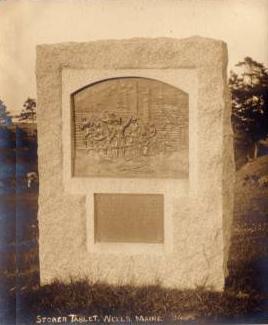Raid on Wells (1692) facts for kids
Quick facts for kids Raid on Wells (1692) |
|||||||
|---|---|---|---|---|---|---|---|
| Part of King William's War | |||||||
 Storer Tablet, which marks the Storer garrison site |
|||||||
|
|||||||
| Belligerents | |||||||
Abenaki Mi'kmaq militia |
|||||||
| Commanders and leaders | |||||||
| Sr. de la Broquerie (La Brognerie. Labocree) † Sr. de Portneuf Baron de St Castin Father Jean Baudoin |
Captain James Converse Joseph Storer |
||||||
| Strength | |||||||
| c. 400 troops and warriors | 31 troops | ||||||
| Casualties and losses | |||||||
| unknown | unknown | ||||||
The Raid on Wells was an attack during King William's War. This war was fought between England and France, along with their Native American allies, in North America. In 1692, French and Wabanaki (Native American) forces from New France attacked the English town of Wells, Maine. Wells was a small town on the coast, near the border of what was then Acadia (French territory). The main attack was led by a French commander named La Brognerie, who was killed during the fight. Despite being greatly outnumbered, Captain James Converse, who was in charge of the town's defense, successfully fought off the attackers.
Contents
Why was Wells important?
Wells was a tough and important town on the edge of English settlement in the northeast. Other attempts to build towns further north in Maine had failed. Many early towns were destroyed by Native American attacks, especially after King Philip's War in 1675. New France did not like English settlers moving into lands it claimed. So, they often worked with the Abenaki people to stop the English from expanding.
What happened before the big raid?
During King William's War, Wells had about 80 houses and log cabins spread along the main road. On June 9, 1691, about 200 Native Americans, led by a chief named Moxus, attacked the town. But Captain James Converse and his local soldiers successfully defended Lieutenant Joseph Storer's fort. This fort was surrounded by a strong fence called a palisade. Another chief, Madockawando, was very angry. He warned that he would return the next year to "have the dog Converse out of his den." As the attackers left, they went to York, Maine and attacked a ship, killing most of its crew. They also burned a small village.
The Big Attack on Wells (1692)
A year later, on June 10, 1692, the people of Wells saw their cattle running into town, scared and some wounded. This was a clear sign that a Native American attack was coming. Everyone quickly went to find safety. A large force of 400 Native Americans and some French soldiers, led by La Brognerie, marched into Wells. They knew Captain Converse would be at Storer's fort.
How did Captain Converse defend the town?
Captain Converse had only 15 soldiers and a few townspeople with him. But they bravely fought off the attackers for two or three days. The attackers tried to storm both the village and the narrow harbor. In the harbor, Captain Samuel Storer, James Gooch, and 14 soldiers had arrived as backup. They were on two small ships called sloops and a smaller boat called a shallop.
The Native Americans shot flaming arrows onto the boats, but the crews quickly put out the fires. Next, the attackers built a shield from wooden planks. They pushed this shield on a cart towards the boats at low tide. La Brognerie and 26 French and Native American fighters hid behind it. But the cart got stuck in the soft mudflats, about 50 feet from the closest boat. When La Brognerie tried to free the wheel, he was shot and killed. The rest of his group ran away, with some falling as bullets rained down.
What other tactics did the attackers use?
The attackers then tried another plan. They floated a large raft, about 18 to 20 feet wide, covered with burning material. They hoped the ebbing tide (when the water goes out) would carry it to the boats. But the wind changed direction, and the burning raft drifted to the opposite shore instead.
Running low on ammunition, the attackers finally gave up and left. Before they left, they burned the church and a few empty houses. They also shot all the cattle they could find. Sadly, John Diamond, who had been captured at the start of the raid, was killed by the attackers. They left some of their dead behind, including La Brognerie. Captain Converse became famous for this victory, where so few defeated so many. Today, a granite monument in Storer Park marks the spot where Lieutenant Storer's fort once stood.
What happened after the raid?
Wells faced more attacks in the years that followed.
Attacks during Queen Anne's War
During Queen Anne's War, another conflict between England and France, Wells was attacked again on August 10, 1703. Thirty-nine people were killed or taken away, and many more were hurt. Houses and barns that had been rebuilt were burned down once more.
The last major Wabanaki attack in Maine during this war also happened in Wells in 1712. Native Americans raided a wedding party, killing three people and briefly taking one prisoner.
Peace and later conflicts
The Treaty of Portsmouth in 1713 brought a period of peace between the Native Americans and the English. However, this peace did not last forever. When Dummer's War began, the Abenaki village of Norridgewock started attacking English settlements near the New England and Acadia border. But on August 23, 1724, soldiers from the Province of Massachusetts Bay traveled up the Kennebec River and destroyed Norridgewock. After this, the region became much safer. After the Battle of Louisburg in 1745, attacks by the Wabanaki Confederacy completely stopped.
Images for kids


